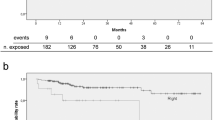Abstract
Background
Central venous access in cancer patients is often challenging. A history of access is common. Appropriate indications for venous imaging studies are not clearly defined.
Methods
This study was a retrospective analysis of selective use of preoperative venous duplex ultrasound and intraoperative venography in 248 consecutive cancer patients undergoing central venous access placement.
Results
Ninety patients had a history of central venous access placement. Eleven had a history of deep venous thrombosis of an upper extremity or central vein. One hundred three underwent preoperative ultrasound. Previous central venous access placement was not associated with an abnormal preoperative ultrasound; however, previous central venous access with deep venous thrombosis was (P=.014). Thirty patients underwent intraoperative venography, of which 18 also had preoperative ultrasound. Fifty percent of patients with an abnormal intraoperative venogram had no abnormal findings on preoperative ultrasound.
Conclusions
Routine preoperative ultrasound is unnecessary. We advocate then selective use of preoperative ultrasound in those with a history of central venous access associated with deep venous thrombosis. We advocate the use of intraoperative venography when there is difficulty advancing the guidewire or catheter or when preoperative ultrasound is negative despite a history of central venous access with deep venous thrombosis.
Similar content being viewed by others
References
Povoski SP, Paz IB. Long-term venous access. In: Pazdur R, Coia LR, Hoskins WJ, Wagman LD, eds.Cancer Management: A Multidisciplinary Approach. Medical, Surgical, and Radiation Oncology. 5th ed. Melville, NY, PRR, 2001; 923–32.
Haire WD, Lynch TG, Lieberman RP, Edney JA. Duplex scans before subclavian vein catheterization predict unsuccessful catheter placement.Arch Surg 1992;127:229–30.
Kraybill WG, Allen BT. Preoperative duplex venous imaging of patients with venous access.J. Surg Oncol 1993;52:244–8.
Selby B, Tegtmeyer CJ, Amodeo C, Bittner L, Atuk NO. Insertion of subclavian hemodialysis catheters in difficult cases: value of fluoroscopy and angiographic techniques.AJR Am J Roentgenol 1989;152:641–3.
Page AC, Evans RA, Kaczmarski R, Mufti GJ, Gishen P. The insertion of chronic indwelling central venous catheters (Hickman lines) in interventional radiology suites.Clin Radiol 1990;42:105–9.
Baxter GM, Kincaid W, Jeffery RF, Millar GM, Porteous C, Morley P. Comparison of colour Doppler ultrasound with venography in the diagnosis of axillary and subclavian vein thrombosis.Br J Radiol 1991;64:777–81.
Perry LJ, Sheiman RG, Hartnell GG. Interventional radiology and cross sectional imaging in venous access.Surg Oncol Clin North Am 1995;4:505–35.
Hübsch PJS, Stiglbauer RL, Schwaighofer BWAM, Kainberger FM, Barton PPA. Internal jugular and subclavian vein thrombosis caused by central venous catheters. Evaluation using Doppler blood flow imaging.J Ultrasound Med 1988;7:629–36.
Knudson GJ, Weidmeyer DA, Erickson SJ, et al. Color Doppler sonographic imaging in the assessment of upper-extremity deep venous thrombosis.AJR Am J Roentgenol 1990;154:399–403.
Lohr JM, Lutter KS, Cranley RD, Sampson MG, Cranley JJ. Upper extremity venous duplex imaging.J Mal Vasc (France) 1992;17:88–90.
Köksoy C, Kuzu A, Kutlay J, Erden I, Özcan H, Ergin K. The diagnostic value of colour Doppler ultrasound in central venous catheter related thrombosis.Clin Radiol 1995;50:687–9.
Forauer AR, Glockner JF. Importance of US findings in access planning during jugular vein hemodialysis catheter placements.J Vasc Interv Radiol 2000;11:233–8.
Povoski SP. A prospective analysis of the cephalic vein cutdown approach for chronic indwelling central venous access in 100 consecutive cancer patients.Ann Surg Oncol 2000;7:496–502.
Spinowitz BS, Galler M, Golden RA, et al. Subclavian vein stenosis as a complication of subclavian catheterization for hemodialysis.Arch Intern Med 1987;147:305–7.
Surratt RS, Picus D, Hicks ME, Darcy MD, Kleinhoffer M, Jendrisak M. The importance of preoperative evaluation of the subclavian vein in dialysis access planning.AJR Am J Roentgenol 1991;156:623–5.
Robbin ML, Gallichio MH, Deierhoi MH, Young CJ, Weber TM, Allon M. US vascular mapping before hemodialysis access placement.Radiology 2000;217:83–8.
Author information
Authors and Affiliations
Corresponding author
Rights and permissions
About this article
Cite this article
Povoski, S.P., Zaman, S.A. Selective use of preoperative venous duplex ultrasound and intraoperative venography for central venous access device placement in cancer patients. Annals of Surgical Oncology 9, 493–499 (2002). https://doi.org/10.1007/BF02557274
Received:
Accepted:
Issue Date:
DOI: https://doi.org/10.1007/BF02557274




